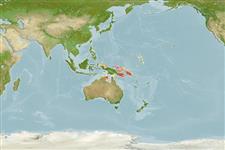Teleostei (teleosts) >
Ovalentaria/misc (Various families in series Ovalentaria) >
Pseudochromidae (Dottybacks) > Pseudochrominae
Etymology: Pseudochromis: Greek, pseudes = false + Greek, chromis = a fish, perhaps a perch (Ref. 45335); lugubris: Named for its sombre coloration and the tear-like marking beneath the eye; Latin name meaning mournful.
More on authors: Gill & Allen.
Environment: milieu / climate zone / depth range / distribution range
Ecology
Marine; reef-associated; depth range 6 - 15 m (Ref. 56434). Tropical
Western Pacific: Papua New Guinea.
Size / Weight / Age
Maturity: Lm ? range ? - ? cm
Max length : 8.2 cm TL male/unsexed; (Ref. 90102)
Short description
Identification keys | Morphology | Morphometrics
Dorsal spines (total): 3; Dorsal soft rays (total): 26 - 27; Anal spines: 3; Anal soft rays: 14. This species is diagnosed by the following characters: D III,26-27; A III,14; lateral line scales 48-50; caudal fin is truncate to emarginate, and sometimes weakly trifurcate (Ref. 56434).
Collected from reef caves, reef overhangs and slopes (Ref. 56434).
Life cycle and mating behavior
Maturity | Reproduction | Spawning | Eggs | Fecundity | Larvae
Gill, A.C. and G.R. Allen, 2004. Pseudochromis lugubris and P. tonozukai, two new dottyback fish species from the Indo-Australian Archipelago (perciformes: Pseudochromidae: Pseudochrominae. Zootaxa 604:1-12. (Ref. 56434)
IUCN Red List Status (Ref. 130435: Version 2024-1)
Threat to humans
Harmless
Human uses
Tools
Special reports
Download XML
Internet sources
Estimates based on models
Preferred temperature (Ref.
123201): 27.4 - 29.3, mean 28.5 °C (based on 142 cells).
Phylogenetic diversity index (Ref.
82804): PD
50 = 0.5000 [Uniqueness, from 0.5 = low to 2.0 = high].
Bayesian length-weight: a=0.00501 (0.00193 - 0.01299), b=3.10 (2.88 - 3.32), in cm total length, based on LWR estimates for this (Sub)family-body shape (Ref.
93245).
Trophic level (Ref.
69278): 3.5 ±0.5 se; based on size and trophs of closest relatives
Fishing Vulnerability (Ref.
59153): Low vulnerability (10 of 100).
